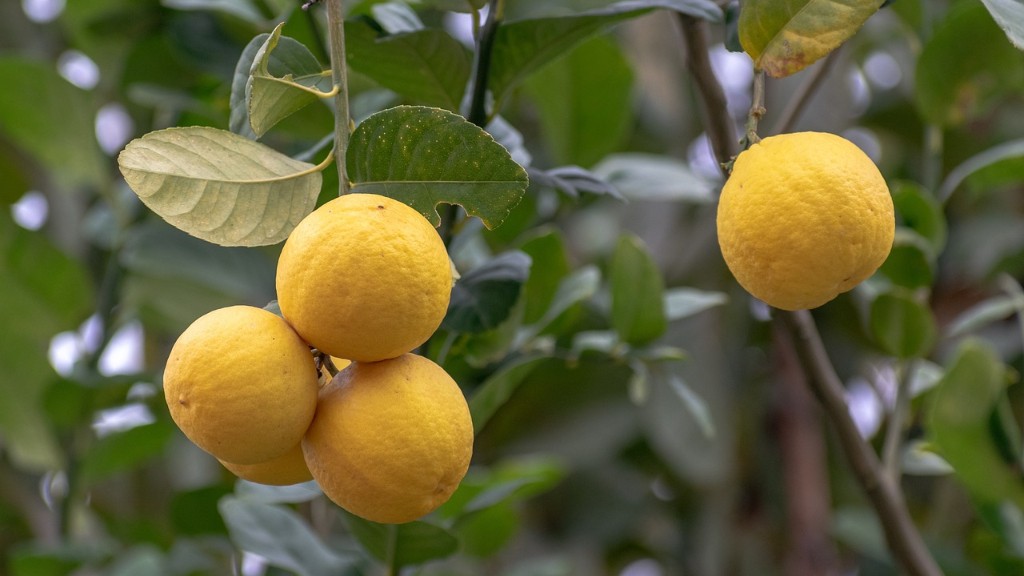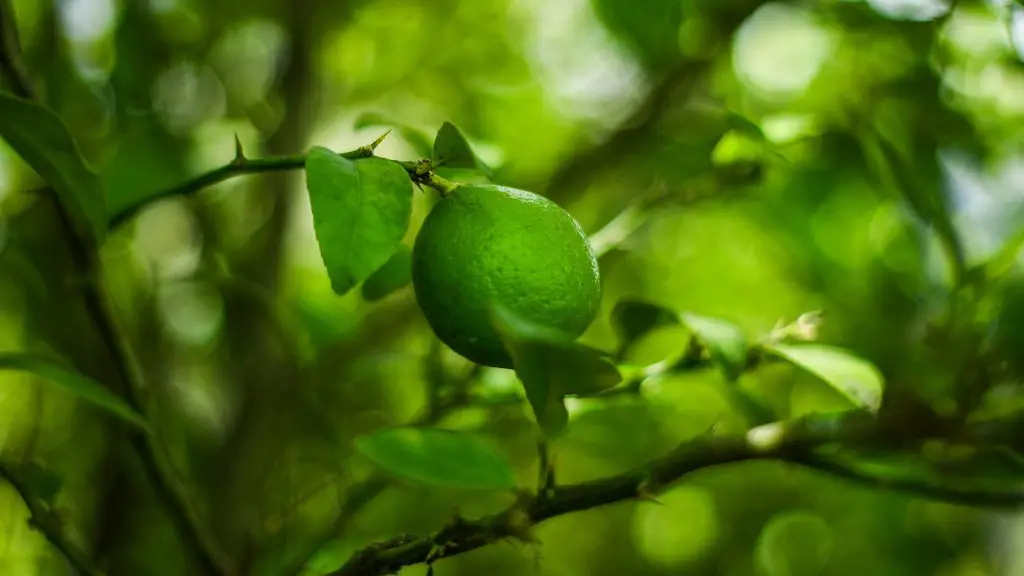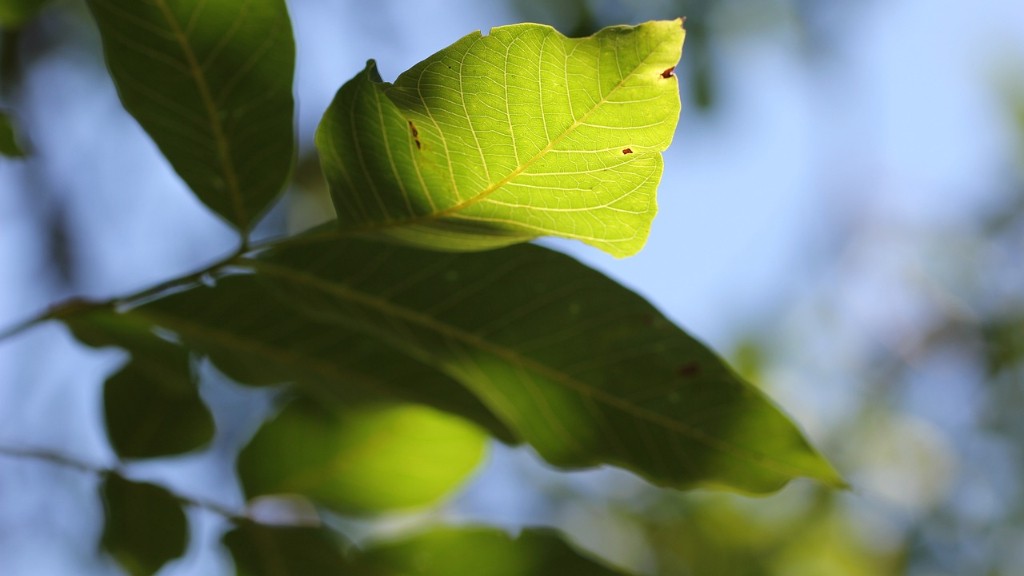Caring for a lemon tree outdoors is not a particularly difficult task. With the right maintenance and attention, your lemon tree can thrive and bear fruit for many years to come. Here are some tips to help you care for your lemon tree and ensure it remains healthy and productive.
Firstly, it is important to provide your lemon tree with the right environment. Ideally, the tree should be planted in a sunny spot that is sheltered from strong winds. Make sure the soil is well drained and mulch with a 3-inch layer of straw, leaves, or pine needles to keep the soil moist.
Secondly, water your tree regularly but not too often, as the soil should not be soggy. To help prevent fungal diseases, water the tree at the base of the trunk rather than on the leaves. A general rule of thumb is to water it about once per week during the growing season.
Thirdly, fertilize your lemon tree in the spring and summer with a nitrogen-rich fertilizer. Also, mulch around the base of the tree to maintain an even soil temperature.
Fourthly, prune the tree in the early spring to help promote foliage growth. Aim to prune the tree just above a set of lateral branches. Remove any dead or damaged branches to help keep the tree healthy.
Fifthly, prevent any issues such as pests or disease by inspecting the tree regularly. If there are any signs of insects or pests, treat the affected areas with a natural, chemical-free insecticide. Also, make sure to keep up with regular pruning and mulching as needed.
Finally, make sure to harvest your lemons as soon as they ripen. Letting them stay on the tree for a long period of time will reduce the tree’s productivity. Make sure to pick ripe fruits as they are more flavorful.
Preparing the Site for Your Lemon Tree
When preparing a site for a lemon tree, it is important to consider factors such as soil type, drainage, and placement in relation to the sun. It is ideal for the soil to be slightly acidic and well-draining, as lemon trees require regular watering. When possible, choose a site that receives at least 8 hours of direct sunlight a day, as this will ensure that the tree gets all the energy it needs to produce fruit. If the soil is not well draining, consider using a pot or grow box to allow for more control of the environment.
When preparing the planting site, it is important to clear away any large stones, weeds, or debris, and turn over the soil a few times. A generous amount of organic matter such as compost, turf, or leafmold should also be added to improve soil fertility and moisture retention. To protect against any weed growth, lay a thick layer of mulch around the planting site.
When planting the tree, make sure to dig a hole that is twice as wide as the pot it is being planted in and no deeper. If using a pot, use a good-quality potting soil to ensure the best growth. Make sure to tamp the soil lightly and water the tree well after planting.
With these tips in mind, you can ensure that your lemon tree has the best chance at a long, healthy life.
Watering
When caring for a lemon tree, proper watering is essential. The tree should be watered regularly but not excessively, as soil that is too wet can lead to root rot or fungal diseases. A general rule of thumb is to water it once per week in the growing season, although this may vary depending on the climate and surrounding environment. It is important to water the tree at the base of the trunk and in the morning if possible to give the leaves time to dry.
It is also important to keep in mind that your lemon tree may require more frequent waterings during periods of extremely hot or dry weather. To keep track of the soil’s moisture and benefit from water-saving techniques, consider using a moisture meter to help measure when it is time to water.
Lastly, adding a thick layer of mulch around the base of your lemon tree can also help reduce evaporation and maintain an even soil temperature.
Fertilizing & Pruning
Fertilizing your lemon tree is important to ensure it receives all the nutrients it needs to remain healthy and productive. A balanced fertilizer, such as a 10-10-10, should be applied in the spring and summer, while a high-nitrogen fertilizer should be used in the autumn. Make sure to follow the instructions on the label to ensure the right amount is applied.
Pruning is also a critical part of caring for a lemon tree. Pruning helps to promote healthy foliage, encourages fruit production and prevents overcrowding of branches. The best time for pruning is in early spring, just before the tree begins to bloom. When pruning, aim to make cuts just above lateral branches and, if necessary, lightly shape the tree by thinning out any overcrowded branches.
It is also important to prune away any dead, diseased, or damaged branches to help keep the tree healthy. Removing any suckers or water sprouts around the base of the tree can also help reduce the risk of pest and disease infestations.
Protecting Against Pest & Disease
Lemon trees are generally resistant to most pests and diseases but they can still be susceptible to insect or fungal damage. To protect your tree, it is important to inspect it regularly and be on the lookout for signs of any pests or diseases that may be present. If there is an infestation, consider using an insecticidal soap or oil that is free of unnecessary, harmful chemicals.
A easy way to help protect your tree is to make sure it is receiving the right amount of water. If the soil around your tree is allowed to become too waterlogged, this can lead to root rot, which is often caused by fungal growth. The root system of your tree can also be damaged due to over-watering. To help prevent this from happening, it is important to check the soil moisture by using a moisture meter.
To further help protect your tree from pests, disease, and other environmental issues, consider using an all-purpose plant protector. This type of spray can help reduce the risk of diseases caused by fungi or insects, as well as reduce damage from extreme temperatures and strong winds.
Harvesting & Winter Care
Harvesting your lemon tree’s lemons is an important part of its care. When the fruits are ripe, it is important to pick them as soon as possible. Keeping them on the tree for too long can reduce the tree’s productivity as the fruits will start to dry out or go off. To check if a fruit is ripe, look for it to be mostly yellow in color and try to push it off the tree with your thumb.
Caring for your lemon tree during the wintertime is also important to keep it healthy and productive. It is important to mulch well around the base of the tree to help protect it from the cold and use an all-purpose plant protector to keep it safe from frost damage. If living in an area that experiences severe cold, it is best to move your tree indoors for the winter or cover it with a frost cloth to provide extra insulation.
During the winter months, it is also important to maintain regular watering and fertilizing of the tree. Generally, the roots will continue to grow in cold temperatures, so providing them with enough water and nutrients is crucial. Make sure to watch for any signs of stress, as this can indicate if the tree needs more or less water.





